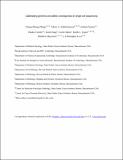Calibrating genomic and allelic coverage bias in single-cell sequencing
Author(s)
Zhang, Cheng-Zhong; Francis, Joshua; Cornils, Hauke; Jung, Joonil; Maire, Cecile; Ligon, Keith L.; Meyerson, Matthew; Adalsteinsson, Viktor A.; Love, John C; ... Show more Show less
Download44800_2_merged_1425397101.pdf (702.6Kb)
PUBLISHER_POLICY
Publisher Policy
Article is made available in accordance with the publisher's policy and may be subject to US copyright law. Please refer to the publisher's site for terms of use.
Terms of use
Metadata
Show full item recordAbstract
Artifacts introduced in whole-genome amplification (WGA) make it difficult to derive accurate genomic information from single-cell genomes and require different analytical strategies from bulk genome analysis. Here, we describe statistical methods to quantitatively assess the amplification bias resulting from whole-genome amplification of single-cell genomic DNA. Analysis of single-cell DNA libraries generated by different technologies revealed universal features of the genome coverage bias predominantly generated at the amplicon level (1–10 kb). The magnitude of coverage bias can be accurately calibrated from low-pass sequencing (∼0.1 × ) to predict the depth-of-coverage yield of single-cell DNA libraries sequenced at arbitrary depths. We further provide a benchmark comparison of single-cell libraries generated by multi-strand displacement amplification (MDA) and multiple annealing and looping-based amplification cycles (MALBAC). Finally, we develop statistical models to calibrate allelic bias in single-cell whole-genome amplification and demonstrate a census-based strategy for efficient and accurate variant detection from low-input biopsy samples.
Date issued
2015-04Department
Massachusetts Institute of Technology. Department of Chemical Engineering; Koch Institute for Integrative Cancer Research at MITJournal
Nature Communications
Publisher
Nature Publishing Group
Citation
Zhang, Cheng-Zhong et al. “Calibrating Genomic and Allelic Coverage Bias in Single-Cell Sequencing.” Nature Communications 6 (April 2015): 6822 ©
2015 Macmillan Publishers Limited
Version: Author's final manuscript
ISSN
2041-1723